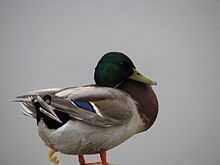Pseudo-penis
A pseudo-penis is any structure found on an animal that, while superficially appearing to be a penis, is derived from a different developmental path.
Mammals
In mammals, all intact developmentally typical males have a penis, but the clitoris in the females of the following species is sufficiently enlarged that it is usually termed a pseudo-penis: spotted hyena,[1] squirrel monkey, lemur,[2] juvenile fossa[3] and binturong.[4] The enlarged clitoris in the fossa is supported by an os clitoridis, a bone similar to the os penis found in most mammals.[3] However, the fossa's os clitoridis and pseudo-penis shrink as the juvenile female grows, unlike that of other pseudo-penis species.[3] The labia of the spider monkey are elongated and may be similarly confused during display. Elongated labia are also observed in humans.
The mammalian pseudo-penis appears to be simply for display, though the spotted hyena is an exception: the female spotted hyena additionally uses her pseudo-penis for urination, copulation, and childbirth. In addition, this makes it difficult for males to mate without the full cooperation of females, which means that mating preferences of the female are predominant.[5]
Female spider monkeys have a clitoris that is referred to as a pseudo-penis because it is especially developed and has a shallow perineal groove that retains and distributes urine droplets as the female moves around.[6] The clitoris of female Geoffroy's spider monkeys is large and protrudes, looking like a penis.[7] This organ, called a pendulous clitoris because of the way it dangles externally, is actually larger than the male flaccid penis.[8] As a result, females are sometimes mistaken for males by human observers.[7] The enlarged clitoris is believed to aid males in determining sexual receptiveness, allowing them to touch the clitoris and smell their fingers to pick up chemical or olfactory cues to the female's reproductive status.[8]
Birds

A notable example of a bird with a pseudo-penis is the Red-billed Buffalo Weaver, which can still mate even if its pseudo-penis is disabled.[9] Only 3% of bird species have a phallus: the common urogenital arrangement for both males and females is the cloaca, through which all elimination and reproduction (via juxtaposed cloacas) occurs, but certain bird species, particularly ratites, screamers, waterfowl, and cracids (a family of arboreal galliformes) exhibit a phallus in the male, a structure derived from the internal cloacal wall which is generally associated with sperm competition. Popularised species include the Ruddy duck and the Argentine lake duck. The corkscrew-shaped phallus of the latter can approach 40 cm in length.[10]
See also
References
- ↑ ADW: Crocuta crocuta: Information
- ↑ Angier 1999, pp. 68–69; Hall 2005, p. 344; Goodman 2009.
- ↑ 3.0 3.1 3.2 Goodman S (2009). "Family Eupleridae (Madagascar Carnivores)". In Wilson D & Mittermeier R. Handbook of the Mammals of the World. Volume 1: Carnivores. Barcelona: Lynx Edicions. ISBN 978-84-96553-49-1.
- ↑
- ↑ Hyenas Encourage Sex With Strangers to Prevent Incest, National Geographic.
- ↑ Dixson, Alan F. (2012). Primate Sexuality: Comparative Studies of the Prosimians, Monkeys, Apes, and Humans. Oxford University Press. p. 364. ISBN 978-0-19-954464-6. Retrieved 2012-11-22.
- ↑ 7.0 7.1 Wainwright, M. (2002). The Natural History of Costa Rican Mammals. Zona Tropical. pp. 146–149. ISBN 0-9705678-1-2.
- ↑ 8.0 8.1 Campbell, C. & Gibson, K. (2008). "Spider monkey reproduction and sexual behavior". In Campbell, C. Spider Monkeys. Cambridge University Press. pp. 266–283. ISBN 978-0-521-86750-4.
- ↑ Avian Reproduction
- ↑ Evolutionary Oddities: Duck Sex Organ, Lizard Tongue